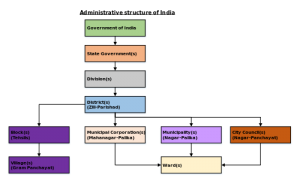Administrative System of Uttar Pradesh
Introduction :-
Uttar Pradesh is bound by Nepal on the North, Himachal Pradesh on the northwest, Haryana on the west, Rajasthan on the southwest, Madhya Pradesh on the south and south- west and Bihar on the east. Situated between 23° 52′ N and 31° 28′ N latitudes and 77° 3′ and 84° 39’E longitudes, this is the fourth largest state in the country. Uttar Pradesh can be divided into three distinct hypsographical regions: 1. The Himalayan region in the North 2. The Gangetic plain in the centre 3. The Vindya hills and plateau in the south.

Administrative System
The general structure of the administration in the district is in a series of tiers, usually three, sometimes four tiers. Level one which comprehends the whole district within its jurisdiction. It may be the Collector, the District Magistrate, or the Superintendent of Police or the district agricultural officer; it may be the chairman of the Zilla Parishad, or the district education officer, or the health officer and so on. Secondly, there is an intermediate territorial level. Sometimes there are two intermediate levels in the large districts. The intermediate level can be the tahsil, or a sub-division, or a block, or a Panchayat Samiti, a circle inspector of agriculture and so on. Then at the ground level, in the so-called grass-roots level, the village provides a convenient territorial jurisdiction. The village panchayat, the nyaya panchayat, the village headman, the village chaukidar, the village patwari, the village level worker – each an important element in the administration of the district.
Divisional administration
The Indian state of Uttar Pradesh is made up of 75 administrative districts, that are grouped into 18 divisions. Each division consists of 3-7 districts. A Divisional Commissioner, an officer of Indian Administrative Service is responsible for heading the administration of a division, the Divisional Commissioner is also responsible for the collection of revenue and maintenance of law and order in his division.
There are also 8 Police zones and 18 Police ranges in the state. Each zone consists of 2-3 ranges and is headed by an Additional Director General ranked officer of Indian Police Service. Whereas a range consists of 3-4 districts and is headed by an Inspector General ranked or a Deputy Inspector General ranked officer of Indian Police Service.
District administration
A district of an Indian state is an administrative geographical unit, headed by a District Magistrate (DM), an officer belonging to the Indian Administrative Service. The District Magistrate is responsible for coordinating the work between various departments in the district, is responsible for law and order in the district and is also given the power of an executive magistrate. The District Magistrate is assisted by a number of officers belonging to Uttar Pradesh Civil Service and other state services.
A Senior Superintendent of Police/Superintendent of Police (SSP/SP), an officer belonging to the Indian Police Service is entrusted with the responsibility of maintaining law and order and related issues of the district. He is assisted by the officers of the Uttar Pradesh Police Service like and other Uttar Pradesh Police officials.
A District Forest Officer, an officer belonging to the Indian Forest Service, in the rank of Deputy Conservator of Forests, is responsible for managing the forests, the environment, and wildlife-related issues of the district with the assistance of the Uttar Pradesh Forest Service.
Sectoral development is looked after by the district head of each development department such as PWD, Health, Education, Agriculture, animal husbandry, etc. These officers belong to the various State Services. These officers have to report to the District Magistrate of the district.
Tehsil
Each sub-division is divided into two or more administrative areas called Tahsils. Tahsil is the basic unit for purposes of general administration, treasury, land revenue, land records and other items of work. It has the closest and widest contact with the rural population. Each tehsil usually comprises between 200-600 villages. The officer-in-charge of the tehsil is the Tehsildar who belongs to the State Civil Services. He is the principal official in the district administration responsible for actual revenue collector. His performance, also, is judged by his efficiency as a Collector of revenues. He is the sub-treasury officer, thus accepting the payment of the revenue. But a Tehsildar who merely sits in a tehsil waiting for the land revenue to come in would not get very far. The Tehsildar is often assisted by the Naib Tehsildars, is Kanungos, and Patwaris or Lekhpals. His main duties include.
BLOCK
Rural areas in districts are divided, for purposes of rural development into blocks, the area of which may or may not coincide with a tahsil (taluk). Each block is in charge of a Block Development Officer, whose immediate superior is the Collector (in some States, the Sub-Divisional Officer). Blocks are further divided into ten circles, each of which is supposed to cover ten villages but, in fact, this is rarely the case. Each circle is in charge of a Village Level Worker.
PANCHAYATS
Finally, there are village panchayats in rural areas of districts. A panchayat is an elective, statutory body representing one or several villages. The average number of villages per panchayat varies significantly from State to State. The average population per Panchayat also varies. It is on the basis of this framework that the main components of the District Administration organise their work. The law, order and land revenue components 113 are organized in the main on a district – sub-division-tahsil-village basis; the community development and Panchayati Raj components are organized on a district-block-panchayat basis.
MUNICIPAL AND CIVIC SYSTEM
Apart from the formal District Administrative structure formulated by the colonial master, India has a long tradition of municipal and civic administration from time immemorial. A brief resume of the municipal and civic system in India is being presented in the succeeding paragraphs.